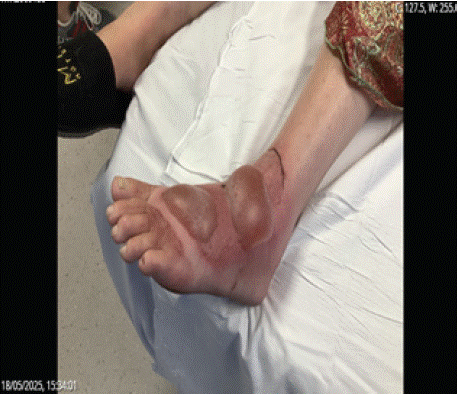Abstract
A 53-year-old woman presented with blistering and erythema of her left foot, initially misdiagnosed as cellulitis and treated with oral antibiotics. She reported vomiting and poor oral intake, but no trauma or fever. Examination revealed two large tense blisters over the dorsum of the foot, with sharply demarcated sparing corresponding to flip-flop straps. Blood tests showed normal inflammatory markers. Further history uncovered recent naproxen use and prolonged sun exposure. A diagnosis of NSAID-induced phototoxicity was confirmed with dermatology input. Management involved discontinuing naproxen, topical corticosteroids, blister drainage, and supportive care. This case highlights an important diagnostic mimic in acute medicine and underscores the value of detailed history-taking and dermatological assessment in atypical skin presentations.
Keywords: Phototoxicity; NSAIDs; Cellulitis mimic; Acute medicine; Blistering rash
Introduction
Dermatological manifestations frequently present diagnostic ambiguities in acute medical scenarios, thus underscoring the imperative for a holistic diagnostic strategy that melds comprehensive patient history, rigorous clinical evaluation, and discerning application of diagnostic tools.
This case report elucidates a scenario involving a 53-year-old woman initially misdiagnosed with cellulitis, thereby highlighting the potential for misdiagnosis and the critical role of detailed clinical assessment in averting inappropriate therapeutic interventions.
Case Summary
A 53-year-old woman re-presented to the acute medical unit with worsening erythema and blistering over her left foot, four days after being treated for presumed cellulitis with oral flucloxacillin. She complained of vomiting and poor oral intake but denied fever, trauma, or insect bites.
On examination, two large tense blisters were noted over the dorsum of the left foot, with surrounding erythema extending to the ankle. A well-demarcated area of sparing, corresponding to flip-flop straps, produced characteristic tan lines. There was no associated oedema, calf tenderness, or systemic signs of infection.
Blood investigations, including CRP and WCC, were within normal limits. Further history revealed recent naproxen use following knee replacement surgery and prolonged sun exposure while working in a conservatory.
A diagnosis of NSAID-induced phototoxicity was made with dermatology input. Naproxen was discontinued, and topical clobetasol initiated. The blisters were aspirated, and oral flucloxacillin was cautiously continued to cover possible secondary infection. Supportive care included analgesia and intravenous fluids (Figure 1).

Figure 1: Diagnosis of NSAID-induced phototoxicity.
Discussion
Phototoxic reactions are caused by the interaction of certain medications with ultraviolet radiation, resulting in direct tissue injury. NSAIDs, particularly naproxen, though infrequently, are known culprits. The clinical picture can closely resemble cellulitis, leading to inappropriate antibiotic use and delays in definitive management.
Key Distinguishing Features Include
• Blistering and erythema confined to sun-exposed areas
• Sharp demarcation in covered regions (e.g., footwear lines)
• Normal inflammatory markers in contrast to infective cellulitis
• Absence of systemic signs of infection
• In this case, the presence of distinct tan lines was a crucial diagnostic clue, underscoring the value of detailed history-taking and physical examination in the acute setting.
A recent review highlights that while phototoxicity is an uncommon adverse effect of NSAIDs, its clinical significance lies in its frequent misdiagnosis. Awareness of this differential can prevent unnecessary investigations, hospital admissions, and antibiotic prescriptions.
Early dermatology input should be sought in atypical or unclear skin presentations. A systematic approach — combining drug history, sun exposure assessment, and examination findings — remains vital in differentiating cellulitis mimics in acute medicine.
Key Learning Points
• Suspect phototoxicity in blistering rashes affecting sunexposed skin, particularly with recent drug exposure.
• Sparing in covered areas (e.g., footwear lines) provides an important diagnostic clue.
• Normal inflammatory markers can assist in distinguishing phototoxicity from true cellulitis.
Prompt dermatology consultation is essential for optimal management of unclear acute dermatologic presentations.
